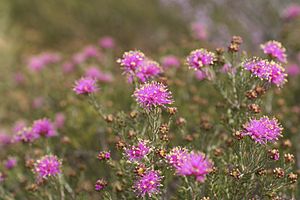Melaleuca psammophila facts for kids
Quick facts for kids Melaleuca psammophila |
|
|---|---|
 |
|
| Scientific classification | |
| Genus: |
Melaleuca
|
| Species: |
psammophila
|
Melaleuca psammophila is a special plant from the Myrtle family, also known as Myrtaceae. It grows only in the south-west part of Western Australia. This small shrub has thin leaves and pretty flowers that can be purple, pink, or mauve. After the flowers, it grows woody, vase-shaped fruits.
This plant looks a bit like another species called M. bisulcata. However, it has different shaped fruits, leaves, and flower buds. Like its relative, Melaleuca psammophila is a beautiful plant with lots of flowers, making it a great choice for gardens.
What it Looks Like
Melaleuca psammophila is a small shrub that usually grows close to the ground. It can reach about 1.5 m (5 ft) tall. Its young branches are covered with soft, woolly hairs. These hairs slowly disappear as the branches get older.
The leaves are arranged one after another along the stems. They have a few short hairs on them. Each leaf is about 2.3–8 mm (0.09–0.3 in) long and 0.6–1.5 mm (0.02–0.06 in) wide. They are long and narrow, with a rounded tip. You can see tiny oil glands on them, and they have two shallow grooves on their underside.
The flowers usually grow in round clusters at the ends of the branches. These branches keep growing even after the flowers bloom. Each flower cluster can be up to 25 mm (1 in) across. They contain up to four groups of three flowers each. The pinkish color of the flowers comes from their stamens, which are the parts that hold pollen. Each stamen has a bright yellow tip called an anther. The stamens are grouped into five bundles around the flowers, with 7 to 15 stamens in each bundle.
This plant blooms in spring and early summer. After the flowers fade, they turn into woody, urn-shaped or vase-shaped seed pods called capsules. These capsules are 4–6.5 mm (0.2–0.3 in) long and grow in clusters along the stems.
How it Got its Name
The plant Melaleuca psammophila was first officially described in 1904. This was done by two scientists, Ludwig Diels and Ernst Georg Pritzel. They wrote about it in a scientific book.
The second part of its name, psammophila, comes from two old Greek words. Psámmos means "sand," and phílos means "friend" or "dear one." So, psammophila means "sand-loving." This name was chosen because this plant loves to grow in sandy places.
Where it Grows
Melaleuca psammophila is found in Western Australia. It grows in areas like Nerren Nerren, Kalbarri, and Geraldton. You can find it in sandy areas called sandplains, which are part of the Geraldton Sandplains and Yalgoo biogeographic regions.
Is it Safe?
The Government of Western Australia's Department of Parks and Wildlife has looked at this plant. They have classified it as "not threatened." This means it is not currently in danger of disappearing.
Growing it at Home
People have successfully grown Melaleuca psammophila in the southern parts of Australia. It grows best in sunny spots with light, well-drained soil. This means the soil doesn't hold too much water.

